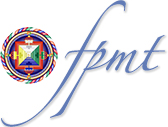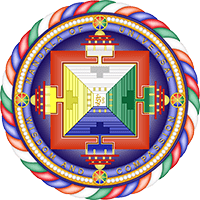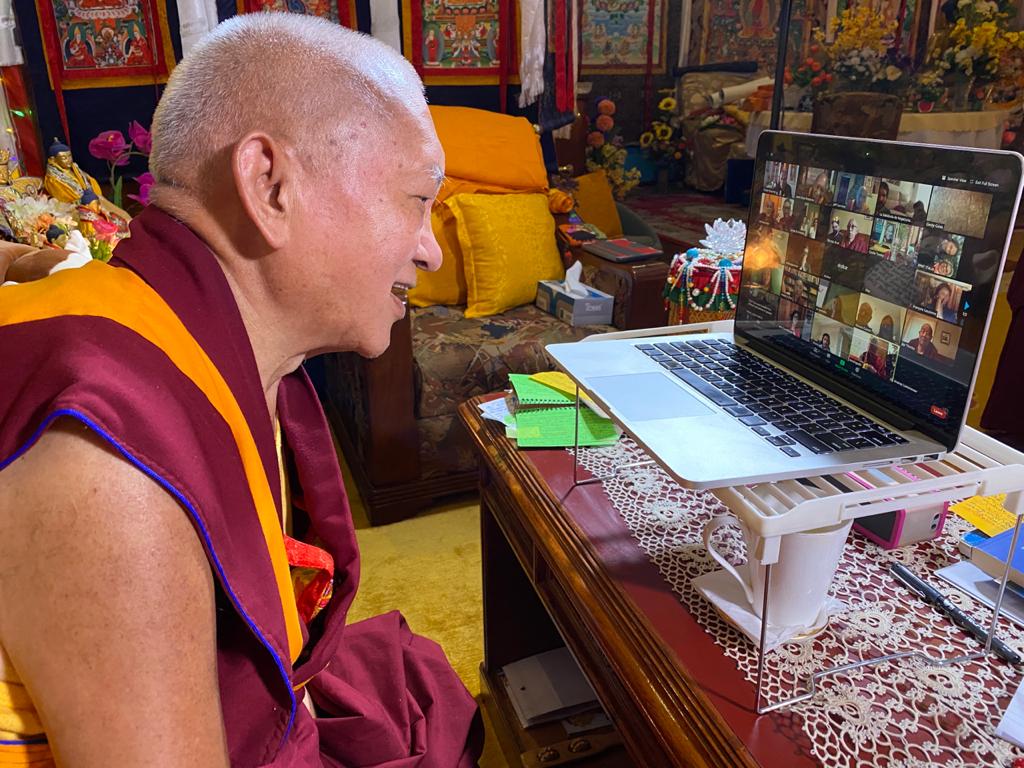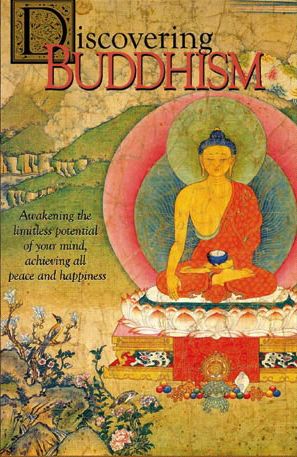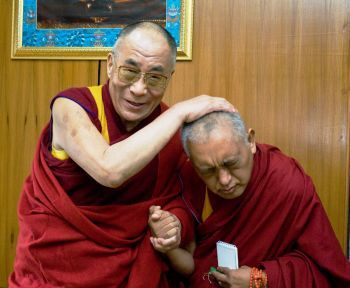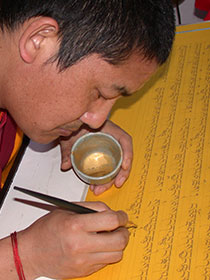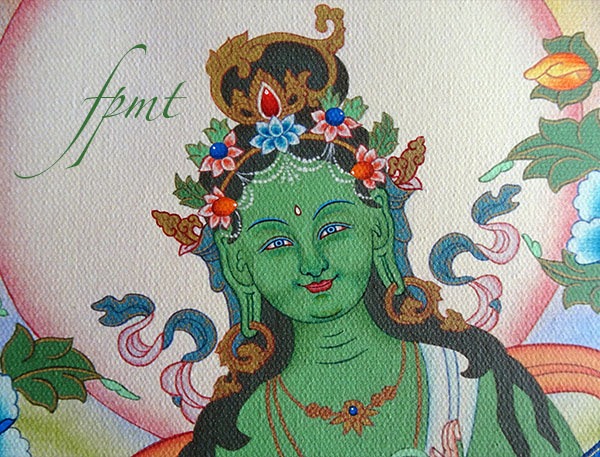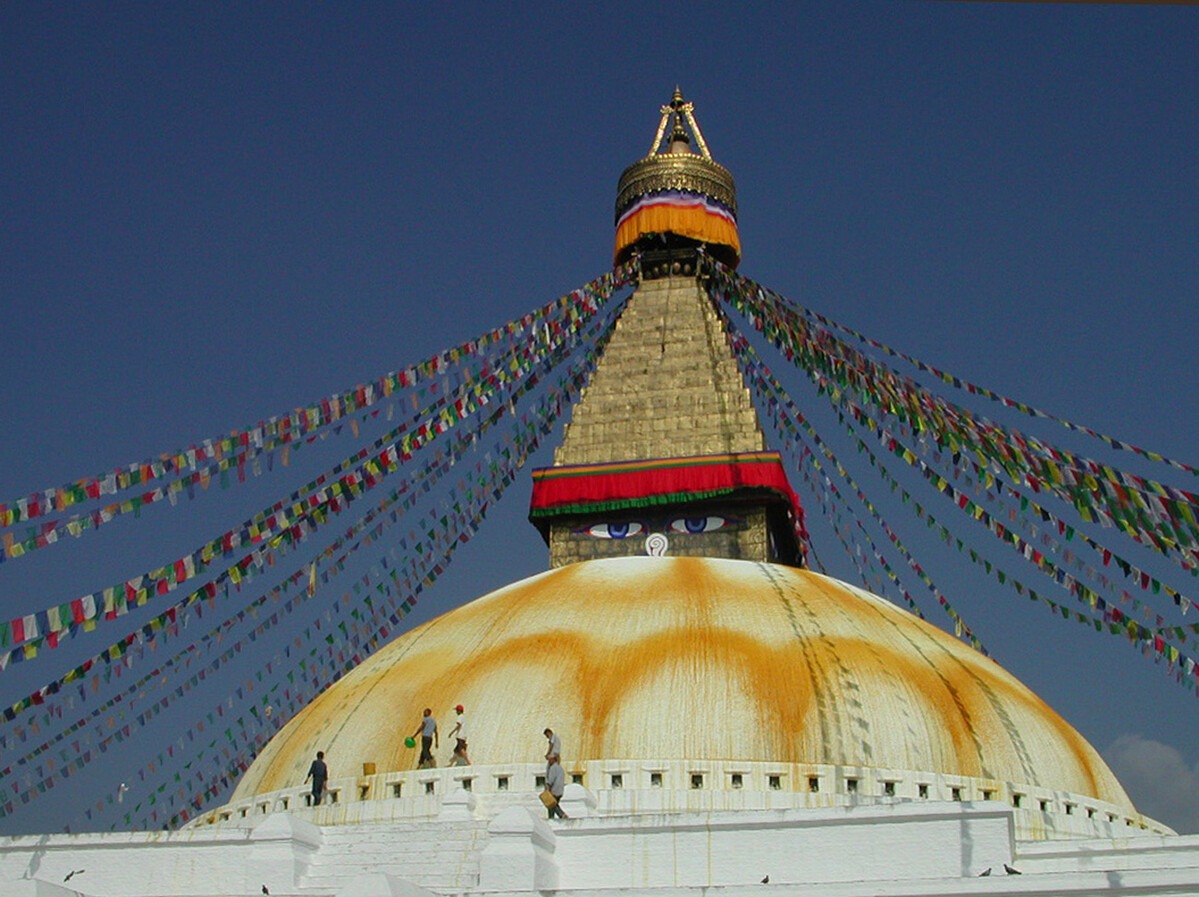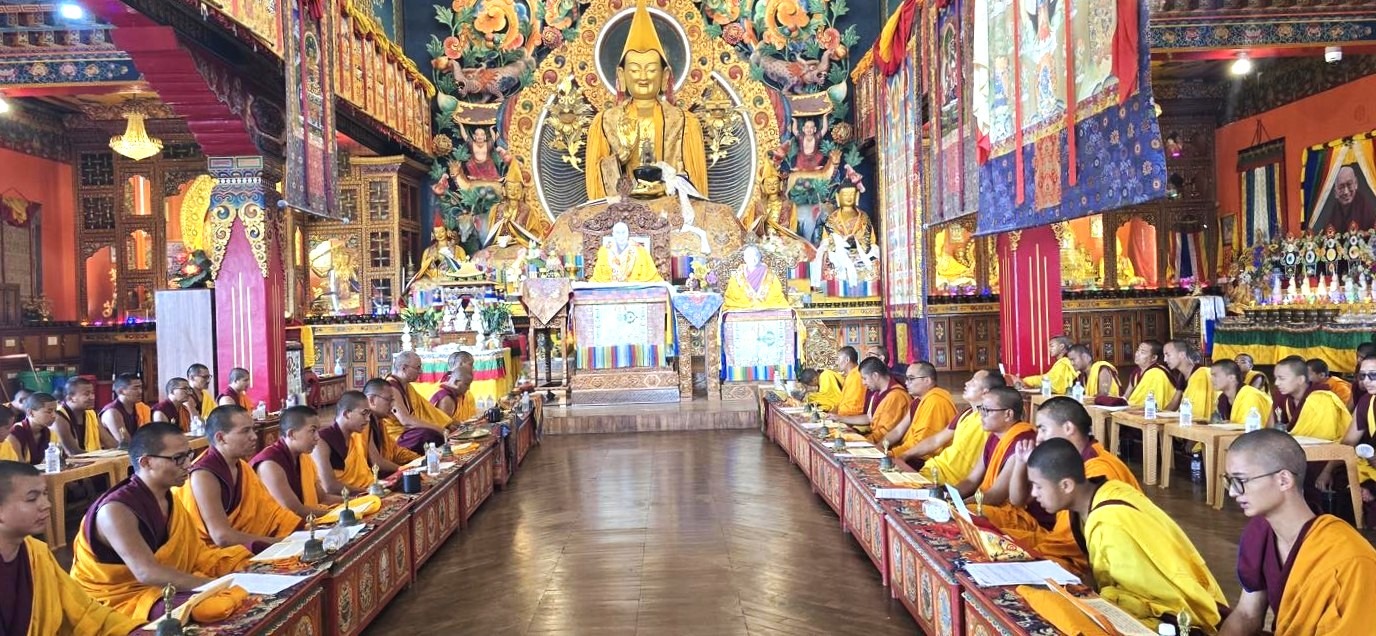- Home
- FPMT Homepage
Foundation for the Preservation of the Mahayana Tradition
The FPMT is an organization devoted to preserving and spreading Mahayana Buddhism worldwide by creating opportunities to listen, reflect, meditate, practice and actualize the unmistaken teachings of the Buddha and based on that experience spreading the Dharma to sentient beings. We provide integrated education through which people’s minds and hearts can be transformed into their highest potential for the benefit of others, inspired by an attitude of universal responsibility and service. We are committed to creating harmonious environments and helping all beings develop their full potential of infinite wisdom and compassion. Our organization is based on the Buddhist tradition of Lama Tsongkhapa of Tibet as taught to us by our founders Lama Thubten Yeshe and Lama Thubten Zopa Rinpoche.
- Willkommen
Die Stiftung zur Erhaltung der Mahayana Tradition (FPMT) ist eine Organisation, die sich weltweit für die Erhaltung und Verbreitung des Mahayana-Buddhismus einsetzt, indem sie Möglichkeiten schafft, den makellosen Lehren des Buddha zuzuhören, über sie zur reflektieren und zu meditieren und auf der Grundlage dieser Erfahrung das Dharma unter den Lebewesen zu verbreiten.
Wir bieten integrierte Schulungswege an, durch denen der Geist und das Herz der Menschen in ihr höchstes Potential verwandelt werden zum Wohl der anderen – inspiriert durch eine Haltung der universellen Verantwortung und dem Wunsch zu dienen. Wir haben uns verpflichtet, harmonische Umgebungen zu schaffen und allen Wesen zu helfen, ihr volles Potenzial unendlicher Weisheit und grenzenlosen Mitgefühls zu verwirklichen.
Unsere Organisation basiert auf der buddhistischen Tradition von Lama Tsongkhapa von Tibet, so wie sie uns von unseren Gründern Lama Thubten Yeshe und Lama Thubten Zopa Rinpoche gelehrt wird.
- Bienvenidos
La Fundación para la preservación de la tradición Mahayana (FPMT) es una organización que se dedica a preservar y difundir el budismo Mahayana en todo el mundo, creando oportunidades para escuchar, reflexionar, meditar, practicar y actualizar las enseñanzas inconfundibles de Buda y en base a esa experiencia difundir el Dharma a los seres.
Proporcionamos una educación integrada a través de la cual las mentes y los corazones de las personas se pueden transformar en su mayor potencial para el beneficio de los demás, inspirados por una actitud de responsabilidad y servicio universales. Estamos comprometidos a crear ambientes armoniosos y ayudar a todos los seres a desarrollar todo su potencial de infinita sabiduría y compasión.
Nuestra organización se basa en la tradición budista de Lama Tsongkhapa del Tíbet como nos lo enseñaron nuestros fundadores Lama Thubten Yeshe y Lama Zopa Rinpoche.
A continuación puede ver una lista de los centros y sus páginas web en su lengua preferida.
- Bienvenue
L’organisation de la FPMT a pour vocation la préservation et la diffusion du bouddhisme du mahayana dans le monde entier. Elle offre l’opportunité d’écouter, de réfléchir, de méditer, de pratiquer et de réaliser les enseignements excellents du Bouddha, pour ensuite transmettre le Dharma à tous les êtres. Nous proposons une formation intégrée grâce à laquelle le cœur et l’esprit de chacun peuvent accomplir leur potentiel le plus élevé pour le bien d’autrui, inspirés par le sens du service et une responsabilité universelle. Nous nous engageons à créer un environnement harmonieux et à aider tous les êtres à épanouir leur potentiel illimité de compassion et de sagesse. Notre organisation s’appuie sur la tradition guéloukpa de Lama Tsongkhapa du Tibet, telle qu’elle a été enseignée par nos fondateurs Lama Thoubtèn Yéshé et Lama Zopa Rinpoché.
Visitez le site de notre Editions Mahayana pour les traductions, conseils et nouvelles du Bureau international en français.
Voici une liste de centres et de leurs sites dans votre langue préférée
- Benvenuto
L’FPMT è un organizzazione il cui scopo è preservare e diffondere il Buddhismo Mahayana nel mondo, creando occasioni di ascolto, riflessione, meditazione e pratica dei perfetti insegnamenti del Buddha, al fine di attualizzare e diffondere il Dharma fra tutti gli esseri senzienti.
Offriamo un’educazione integrata, che può trasformare la mente e i cuori delle persone nel loro massimo potenziale, per il beneficio di tutti gli esseri, ispirati da un’attitudine di responsabilità universale e di servizio.
Il nostro obiettivo è quello di creare contesti armoniosi e aiutare tutti gli esseri a sviluppare in modo completo le proprie potenzialità di infinita saggezza e compassione.
La nostra organizzazione si basa sulla tradizione buddhista di Lama Tsongkhapa del Tibet, così come ci è stata insegnata dai nostri fondatori Lama Thubten Yeshe e Lama Zopa Rinpoche.
Di seguito potete trovare un elenco dei centri e dei loro siti nella lingua da voi prescelta.
- 欢迎 / 歡迎
简体中文
“护持大乘法脉基金会”( 英文简称:FPMT。全名:Foundation for the Preservation of the Mahayana Tradition) 是一个致力于护持和弘扬大乘佛法的国际佛教组织。我们提供听闻,思维,禅修,修行和实证佛陀无误教法的机会,以便让一切众生都能够享受佛法的指引和滋润。
我们全力创造和谐融洽的环境, 为人们提供解行并重的完整佛法教育,以便启发内在的环宇悲心及责任心,并开发内心所蕴藏的巨大潜能 — 无限的智慧与悲心 — 以便利益和服务一切有情。
FPMT的创办人是图腾耶喜喇嘛和喇嘛梭巴仁波切。我们所修习的是由两位上师所教导的,西藏喀巴大师的佛法传承。
繁體中文
護持大乘法脈基金會”( 英文簡稱:FPMT。全名:Found
ation for the Preservation of the Mahayana Tradition ) 是一個致力於護持和弘揚大乘佛法的國際佛教組織。我們提供聽聞, 思維,禪修,修行和實證佛陀無誤教法的機會,以便讓一切眾生都能 夠享受佛法的指引和滋潤。 我們全力創造和諧融洽的環境,
為人們提供解行並重的完整佛法教育,以便啟發內在的環宇悲心及責 任心,並開發內心所蘊藏的巨大潛能 — 無限的智慧與悲心 – – 以便利益和服務一切有情。 FPMT的創辦人是圖騰耶喜喇嘛和喇嘛梭巴仁波切。
我們所修習的是由兩位上師所教導的,西藏喀巴大師的佛法傳承。 察看道场信息:
- FPMT Homepage
- News/Media
-
- Study & Practice
-
-
- About FPMT Education Services
- Latest News
- Programs
- New to Buddhism?
- Buddhist Mind Science: Activating Your Potential
- Heart Advice for Death and Dying
- Discovering Buddhism
- Living in the Path
- Exploring Buddhism
- FPMT Basic Program
- FPMT Masters Program
- FPMT In-Depth Meditation Training
- Maitripa College
- Lotsawa Rinchen Zangpo Translator Program
- Universal Education for Compassion & Wisdom
- Online Learning Center
-
- Prayers & Practice Materials
- Overview of Prayers & Practices
- Full Catalogue of Prayers & Practice Materials
- Explore Popular Topics
- Benefiting Animals
- Chenrezig Resources
- Death & Dying Resources
- Lama Chopa (Guru Puja)
- Lama Zopa Rinpoche: Compendium of Precious Instructions
- Lama Zopa Rinpoche: Life Practice Advice
- Lama Zopa Rinpoche Practice Series
- Lamrim Resources
- Mantras
- Prayer Book Updates
- Purification Practices
- Sutras
- Thought Transformation (Lojong)
- Audio Materials
- Dharma Dates - Tibetan Calendar
- Translation Services
- Publishing Services
- Ways to Offer Support
- Prayers & Practice Materials
-
- Teachings and Advice
- Find Teachings and Advice
- Lama Zopa Rinpoche Advice Page
- Lama Zopa Rinpoche: Compendium of Precious Instructions
- Lama Zopa Rinpoche Video Teachings
- ༧སྐྱབས་རྗེ་བཟོད་པ་རིན་པོ་ཆེ་མཆོག་ནས་སྩལ་བའི་བཀའ་སློབ་བརྙན་འཕྲིན།
- Podcasts
- Lama Yeshe Wisdom Archive
- Buddhism FAQ
- Dharma for Young People
- Resources on Holy Objects
- Teachings and Advice
-
-
*If a menu item has a submenu clicking once will expand the menu clicking twice will open the page.
-
-
- Centers
-
- Teachers
-
- Projects
-
-
-
-
*If a menu item has a submenu clicking once will expand the menu clicking twice will open the page.
-
-
- FPMT
-
-
-
-
-
When you meet miserable conditions, it is extremely important to use skillful means. In other words, there is a meditation to mix with whatever suffering you experience. When you apply the teachings in this way, all sufferings are mixed with virtue. All experiences of suffering become virtue.
Lama Zopa Rinpoche
-
-
-
- Shop
-
-
-
The Foundation Store is FPMT’s online shop and features a vast selection of Buddhist study and practice materials written or recommended by our lineage gurus. These items include homestudy programs, prayers and practices in PDF or eBook format, materials for children, and other resources to support practitioners.
Items displayed in the shop are made available for Dharma practice and educational purposes, and never for the purpose of profiting from their sale. Please read FPMT Foundation Store Policy Regarding Dharma Items for more information.
-
-
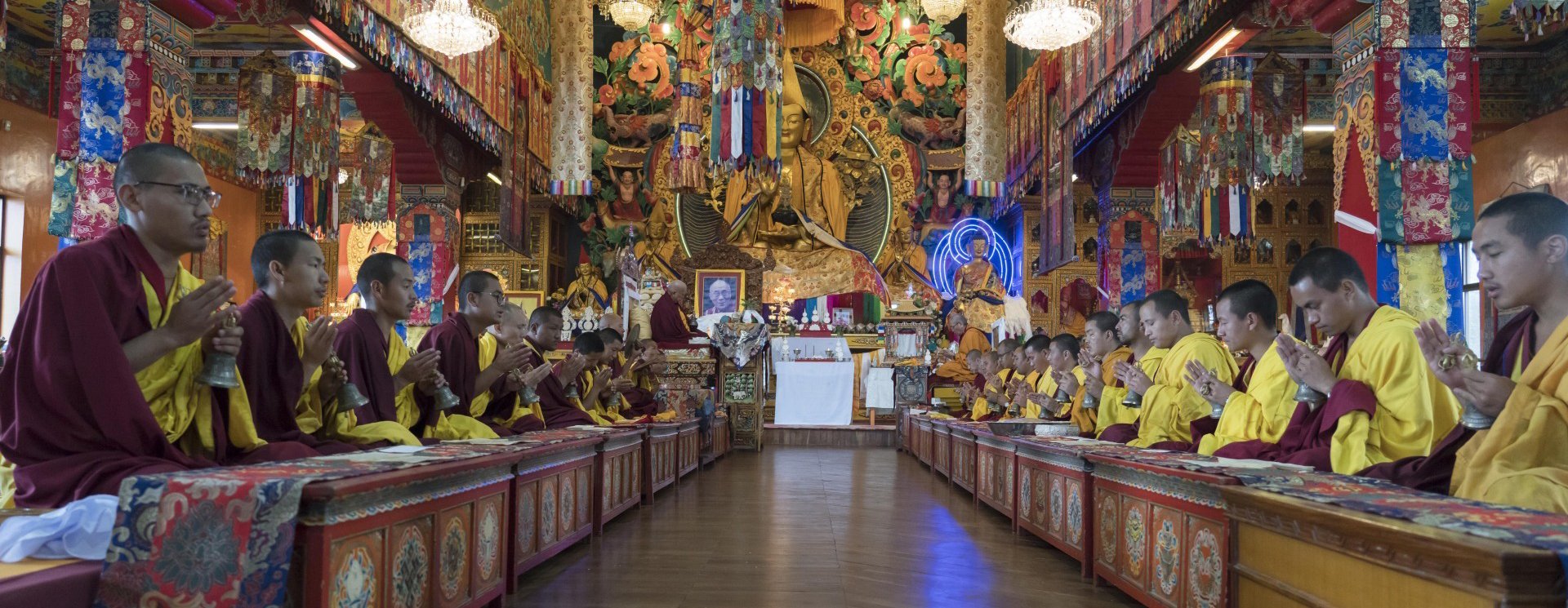
Puja Fund
DONATE | Latest News
A Vast Array of Prayers, Pujas, and Offerings for the Benefit of All
The Puja Fund sponsors extensive and powerful prayers and practices dedicated for the benefit of all beings - particularly all of those within the FPMT organization, and every donor who contributes to this fund. The selected practices we sponsor are specifically for healing, success, the removal of obstacles, and are offered by up to 10,000 ordained Sangha on the most powerful days when merit is magnified.
In addition to the continual prayers being offered, the Puja Fund also arranges monthly offerings of gold, saffron, brocade, robes, and umbrellas to some of the holiest statues and stupas in India, Nepal, and when possible in Tibet.
Lama Zopa Rinpoche initiated the Puja Fund in 1995, and this important fund has been sponsoring continual prayers and practices since then. Rinpoche has been intricately involved in providing guidance on which pujas and practices are best, when they should be offered, and which monasteries and nunneries should offer them, in order for each prayer and practice to be most effective with the biggest impact and benefit. Rinpoche has also composed the special dedication prayer that is recited after all the prayers.
You can also be part of this vast offering of prayers by contributing any amount, rejoicing in the prayers, and dedicating your offering.
The merit that is created from all these pujas is also your merit. So you can dedicate all these merits to having realizations and to achieve enlightenment.
—Lama Zopa Rinpoche

Losar pujas with Ganden Tri Rinpoche, Lama Zopa Rinpoche and Khen Rinpoche Geshe Chonyi, Kopan Monastery, Nepal, February 2023. Photo by Ven. Lobsang Sherab.
The Prayers, Pujas, and Practices Offered
The extensive prayers, pujas, and practices that are continually being offered are specifically for:
- Healing, health, and long life
- Protection from obstacles
- Success needed to actualize the path to enlightenment and for one’s Dharma endeavors
- Accumulation of merit from making prayers and offerings to holy objects, Sangha, and gurus
- Protecting the environment and all living beings
Every month on the Tibetan eighth day, an important day to offer long life practices, the Puja Fund sponsors the 1,600 monks of Sera Mey Monastery to offer the Extensive Medicine Buddha Puja. This practice is a specialty of Sera Mey Monastery – the monks are experts in this practice and offer it with strong prayers. The Puja Fund offers the lights and torma offerings for the actual puja and a small monetary offering to every Sangha in the puja, as well tea and bread.
Medicine Buddha is specifically for health, long life, success, and the removal of obstacles.
Rinpoche has said, “The Medicine Buddha encompasses all the buddhas. This means that when we practice the Seven-limb Prayer and make offerings with the seven limbs, we receive the same merit as we would if we had made offerings to all the buddhas.
“To recite the Medicine Buddha mantra brings inconceivable merit. Manjushri requested the eight tathagatas (Guru Shakyamuni Buddha and the seven Medicine Buddhas) to reveal a special mantra that would make the prayers they (the eight tathagatas) made in the past (prayers to be able to actualize the happiness of sentient beings by attaining the path to enlightenment and pacifying various problems, to be able to see all the buddhas, and for all wishes to be quickly realized) to quickly come to pass, especially for those sentient beings born in the time of the five degenerations who have small merit and who are possessed and overwhelmed by various diseases and spirit harms.
“During that time, all the eight tathagatas, in one voice, taught the Medicine Buddha mantra. Therefore, when you recite the mantra, the buddhas and bodhisattvas will always pay attention to you, and they will guide you. Vajrapani, owner of the secrets, and the four guardians will always protect and guide you. All your negative karmas will be pacified, and you will never be born in the three lower realms. Even just hearing a recitation of the names of the eight tathagatas pacifies all diseases and spirit harms – even spirit harms that arise as a condition of disease – and all your wishes are fulfilled.”
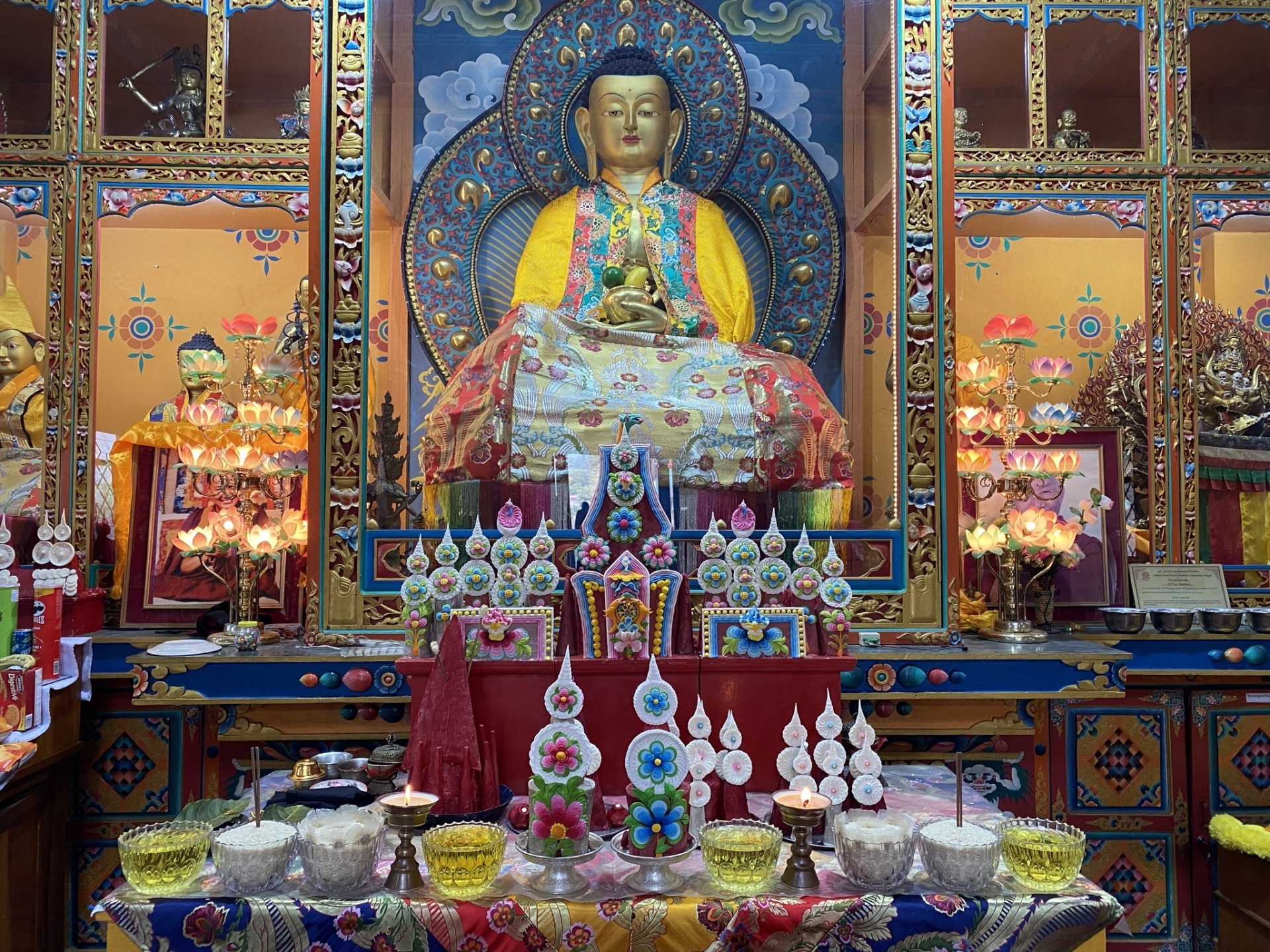
Most Secret Hayagriva Puja torma and altar.
Every month on the Tibetan twenty-ninth day, an important day to offer protector pujas, the Puja Fund sponsors forty of the most senior monks of Sera Je Monastery, who specialize in the practice of Most Secret Hayagriva, to offer the Extensive Most Secret Hayagriva Puja (Hayagriva Tsog Kong). This is an all-day puja with an elaborate torma offering and the puja has extensive prayers and meditations.
The Puja Fund makes a small offering to the monks who perform the puja, sponsors meals and tea on the day of the puja, and covers the cost of extensive torma offerings.
Hayagriva is the wrathful manifestation of Chenrezig, the Buddha of Compassion. This puja is very powerful as a means for removing obstacles and generating merit, and is very important for FPMT, due to the organization’s close connection with this deity which is FPMT’s main protector.
The word “torma” is Tibetan (the Sanskrit word is “balingta”) and refers to an offering cake used in rituals. There are various types of tormas for different purposes. Tormas can be ornamented in many ways, such as with discs molded from butter that represent the sun and moon, as well as more extensively with intricate and colorful auspicious symbols, animals, offering goddess, and much more all made from butter. Lama Zopa Rinpoche explains the significance of tormas, such as the very elaborate one in Most Secret Hayagriva Puja:
“So one meaning of “torma” is destroying your miserliness and attachment, so therefore tormas are made very rich, the best and richest quality you can make. It means you spend money destroying your miserliness, making a good offering to the deity. So that’s one meaning of tor, that which destroys your miserliness, your attachment.
“Then the other meaning is related also to the maha-anuttara tantric path, where the experience of transcendental wisdom, the great bliss, the voidness, is the real torma. That is the real torma … So then that tor destroys like a bomb; it destroys the root of samsara: the ignorance holding the I, the aggregates, to be truly existent. So the torma is that which destroys that.”
On Saka Dawa (one of the four great holy days of the Tibetan calendar, commemorating Shakyamuni Buddha’s birth, enlightenment, and passing into parinirvana) 100,000 Praises to the Twenty-one Taras are beautifully offered by the 400 nuns of Khachoe Ghakyil Ling Nunnery in Nepal and by over 5,000 monks of Sera Je and Sera Mey Monastery.
Tara the Liberator, is a completely enlightened buddha who had previously promised to appear, after enlightenment, in the form of a female bodhisattva for the benefit of all beings. Her primary activity is to protect from the eight fears. Tara is one of the most widely venerated deities in Tibet and represents the miraculous activities of all buddhas. She is said to be born from Chenrezig’s tears of compassion. There are innumerable manifestations of Tara arising according to the needs of others, such as the dynamic Green Tara who quickly overcomes obstacles and saves beings in dangerous situations.
Rinpoche has said, “There are so many inner obstacles to the development of your mind, and these inner obstacles create many outer obstacles. Therefore, for the success of your Dharma practice, of your actualizing the graduated path to enlightenment, you must rely upon a special deity, or buddha, such as Tara. All the actions of the buddhas have manifested in this female aspect of buddha, Tara the Liberator, in order to help living beings to accomplish successfully both temporal and ultimate happiness.”
The Puja Fund makes a small monetary offering to all the Sangha who offer the puja, as well as sponsoring tea and bread during the puja.
Kangyur
The Kangyur is comprised of 108 volumes of the Indian texts that are considered to be the words of Shakyamuni Buddha. It has 1,169 texts within it, containing 70,000 pages. It is recited annually on Chokor Duchen (the anniversary of Guru Shakyamuni Buddha’s first teaching) by the 400 nuns of Khachoe Ghakyil Ling Nunnery in Nepal.
The meaning of “Kangyur” is “the translated words (of the Buddha).” It is the entire collection of texts regarded as buddhavacana or “Buddha-word”, translated into Tibetan.
The texts considered to be “Buddha-word” are the records – not only of the Buddha’s own discourses – but also of teachings and explanations given by others, often by his close disciples with his approval, or by other enlightened beings. Also included are systematic compilations of the Buddha’s pronouncements on particular topics such as the rules of monastic discipline in the Vinaya texts.
Prajnaparamita
The Prajnaparamita is the collection of teachings on the perfection of wisdom (emptiness). It is comprised of small, middle, and large versions, the largest consisting of 100,000 lines. It is recited on each of the four Buddha days by the 500 monks of Gyudmed Tantric College in South India.
Lama Zopa Rinpoche has said, “The beginning of the Madhyamakavatara text says that [the perfection of wisdom] is called ‘mother’ because all the numberless past, present, and future buddhas have been born from this perfection of wisdom. Also, the numberless bodhisattvas and numberless arhats are born from this wisdom. This wisdom is what liberates numberless sentient beings from all the oceans of samsaric suffering. It is the real Dharma, the real refuge that liberates us from the oceans of samsaric suffering, whose continuation has no beginning.
“This Prajnaparamita teaching is so precious, unbelievably precious. The Buddha said, ‘Wherever this Prajnaparamita teaching is, I am there.’ The Buddha said to Kunga (Ananda) that even if other teachings are destroyed that is okay, but one should not degenerate or allow even a little bit of the teaching of the Prajnaparamita to be destroyed.”
The Puja Fund makes a small monetary offering to all the Sangha who offer these incredibly precious recitations of the Kangyur and Prajnaparamita, as well as offering meals, tea, and bread during the recitation.
On each of the four Buddha Days, extensive long life practices are offered to Buddha Namgyalma. The two practices offered are Namgyal Tong Cho which is an extensive Namgyalma long life ritual and Namgyal Tsechog which consists of making one thousand sets of the seven types of offerings to Buddha Namgyalma.
These practices are offered on every Buddha day by the monks of Gyuto, Drepung Gomang, Drepung Loseling, Sera Je, Sera Mey and Kopan Monasteries.
Namgyalma is a female deity for long life and purification. The mantra has infinite benefits; it is so powerful.
Lama Zopa Rinpoche has said, “The kind and compassionate Guru Shakyamuni Buddha taught the benefits of reciting the Namgyalma mantra to the four guardians. If you wash the body, wear clean clothes and, while living in the eight precepts, recite the mantra 1,000 times, even if you are in danger of death due to past karma, your lifespan can be prolonged, the obscurations purified, and you are freed from disease.”
The Puja Fund makes a small monetary offering to all the Sangha offering these extensive practices as well as offering tea and bread during the recitation.
The Puja Fund sponsor pujas, practices, and prayers to pacify the elements and protect those harmed by disasters of earth, wind, fire, and water.
One can feel powerless in the face of disasters of the elements such as earthquakes, tsunamis, wildfires, hurricanes, typhoons, etc. Lama Zopa Rinpoche discussed this in a letter to a student who lived in an area prone to hurricanes:
Lama Zopa Rinpoche advised specific practices and pujas to be offered monthly in order to benefit any being that is harmed from potential disasters and also to purify the karma that creates these dangers in USA and throughout the world.
Arranging and sponsoring these pujas is one of the unique ways that FPMT can benefit sentient beings. This is also an aspect of social service to others that helps address the karmic conditions contributing to seemingly “natural” occurring disasters, and those harmed by them.
Sponsored Monthly Practices Advised by Lama Zopa Rinpoche
If you wonder what to do, what prayers to make when there are disasters caused by the elements (fire, water, wind, and earth) such as tornados, hurricanes, heavy rain, storms, floods, earthquakes, fires; as well as disasters that destroy crops; disasters that destroy entire towns and cities within one hour; disasters that cause so many billions of dollars of damage and so much money has to be spent to rebuild the towns; disasters where so many hundreds and thousands of people die or lose their homes, have no food or clean water; disasters where so many animals and insects are killed and harmed – Here I am offering some suggestions on what to do so that you can help a country at risk, save so many lives, and prevent the destruction of houses, villages, and cities.
—Lama Zopa Rinpoche, July 2018
Each month the following practices are sponsored and dedicated to pacify the elements and protect those harmed by disasters of earth, wind, fire, and water. Lama Zopa Rinpoche advised on the exact practices to be done, how many times they should be completed, and by whom:
- Extensive Medicine Buddha Puja offered five times by Drepung Gomang Monastery, Kopan Monastery, and Gyuto Tantric College
- Guhyasamaja root text recited four times by Kopan Lama Gyupas
- Kshitigarbha Sutra recited one time by the sangha and students in in USA
- Sutra of Golden Light recited eight times by Sangha in the USA
- Arya Sanghata Sutra recited five times by Sangha in the USA
- Vajra Cutter Sutra recited four times by Yangsi Rinpoche
Practices that Can Be Done By Anyone
There are many practices that can be done by anyone wishing to help mitigate the effects of natural disasters:
- Extensive Medicine Buddha Puja
- Sanghata Sutra recitation
- Vajra Cutter Sutra recitation
- Guhyasamaja root text recitation (currently in the process of being translated into English)
- Sutra of Golden Light recitation
- 108 Names of Kshitigarbha
Sutras are records of teachings given by the historical Buddha, Shakyamuni. The Buddha’s discourses were memorized by his disciples and later written down in various languages, the most complete collections of teachings being in Pali and Sanskrit. Because sutras contain the actual words spoken by the Buddha, by reproducing that speech ourselves during recitations our voice becomes a conduit for the spread of Buddha’s teachings in the world. A special set of sutras called dharmaparyayas or “transformative teachings,” including the Sanghata Sutra, function to transform those who hear, recite, or write them out in particular ways, in the same way as meeting a buddha in the flesh.
Golden Light Sutra
This “King of Glorious Sutras” contains everything needed, from daily happiness to complete enlightenment. It contains a profound practice of confession and rejoicing, profound teachings on dependent arising, reliable assurances of protection, guidelines for ideal government, and awe-inspiring stories of the Buddha’s previous lives.
This sutra is printed a minimum of six times on each of the four Buddha Days and every sun and moon eclipse. It is also recited monthly by Sangha.
Arya Sanghata Sutra
The Arya Sanghata Sutra promises to transform all those who read it. Like other sutras, the Sanghata Sutra records an oral teaching given by the Buddha, but unlike other sutras, Buddha explains that he himself had heard this sutra from a previous Buddha. The Sanghata Sutra is a text that talks about itself by name and talks in great detail about what it will do to anyone who encounters it. It is also an extraordinary literary adventure, full of stories of death, discovery and transformations.
This sutra is printed a minimum of ten times on each of the four Buddha Days and every sun and moon eclipse. It is also recited monthly by Sangha.
Vajra Cutter Sutra
The Vajra Cutter Sutra is one of most well-known sutras of Mahayana Buddhism. The Vajra Cutter Sutra is a discourse on the Buddhist concept of emptiness or “Wisdom Gone Beyond.”
Rinpoche has said, “The Vajra Cutter Sutra is unbelievable. It is one of the most profitable practices, because the root of all sufferings, yours and others, is the ignorance holding “I” as truly existent – even though it is empty of that; and the ignorance holding the aggregates as truly existent, even though they are empty of that. The only antidote to cut that, to get rid of that and through which to achieve liberation, the total cessation of the suffering causes – delusions and karma – is the wisdom realizing emptiness. This is the subject of the Vajra Cutter Sutra, emptiness. So, each time you read it, it leaves such a positive imprint.”
This sutra is printed a minimum of two hundred times on each of the four Buddha Days and every sun and moon eclipse. It is also recited monthly by Sangha.
Amitayus Long Life Sutra
According to Lama Zopa Rinpoche, “This text is very precious and there is so much benefit in printing or writing it. This is one of the texts that, if written in gold, mountains of negative karma gets purified. It’s very good to print for people who have cancer, and for the success of activities and projects. If a business has difficulties, or is difficult to start, if you have difficulty finding a job, or the job is not going well, you can print many copies to make merit, not particularly for mundane success but generally to collect merit for realizations, conditions for Dharma practice. Then you can dedicate the merits of printing for all sentient beings. This is one solution for success and long life. Also, when you die you will get born in Amitabha’s pure land.”
This sutra is printed a minimum of twenty times on each of the four Buddha Days and every sun and moon eclipse.
The Sutra of Great Liberation
The Sutra of Great Liberation is an important Mahayana sutra that is also often recited and greatly cherished in Tibet. The sutra contains teachings on various topics, as well as the names of many enlightened beings. The sutra is often recited for those who have passed away, and even just having a copy of it has great benefits.
This sutra is printed a minimum of two times on each of the four Buddha Days and every sun and moon eclipse.
Offerings to Boudhanath and Swayambunath Stupas
Lama Zopa Rinpoche has said that in the Guhyasamaja text (one of the higher tantras) it says, “A stupa is a palace where all the buddhas are abiding. Those beings who don’t have the karma actually to see buddha need the holy objects of body, speech and mind – statues, scriptures, stupas – as a field for accumulating merit. Sentient beings accumulate extensive merit by making offerings to holy objects, and from this merit, happiness comes. As soon as a statue of the Buddha or a stupa is completed, in that very second it becomes an object with which beings can create the cause of happiness. Having one more holy object gives sentient beings one more opportunity to create merit. The continued existence and flourishing of the teachings of the Buddha depend on the continued existence of the holy objects of Buddha”.
All are welcome to participate in these offerings that are happening every month. We are incredibly fortunate that the offerings have all been set up and arranged and anyone can be a part of them. Even just remembering and rejoicing in the offerings brings tremendous merit.
With offer sincere thanks to Kopan Monastery for arranging these offering.
Jowo Buddha Statue, Tibet
When possible the Puja Fund sponsors the offering of robes and gold to the holy face of the Jowo Buddha statue in Tibet and once a year gold is offered to the entire holy body.

The main Shakyamuni Buddha statue inside the Mahabodhi Temple, Bodhgaya, India.
Mahabodhi Temple Statue, Bodhgaya
Every month, on the full moon and on the four Buddha Days when merit is multiplied 100 million times, a new set of robes are offered to the Buddha statue in the Mahabodhi Temple in Bodhgaya.
Lama Zopa Rinpoche has taught extensively on the benefits of offering to statues of Buddha. “If someone offers a small flower or rice to a Buddha statue, a stupa, or scripture then the benefit extends from then up to enlightenment. Amazing, amazing,” Rinpoche has said. “It is said in the sutra Piled Flowers, on top of that benefit, you achieve ultimate happiness, liberation from the causes of delusion and karma, and on top of that full enlightenment, all the realizations and omniscient mind. After this, then you liberate numberless hell beings, pretas, animals, humans, suras and asuras from the ocean of samsaric sufferings and bring them to full enlightenment. When all beings are brought to enlightenment, only then are all the results of offering achieved.”
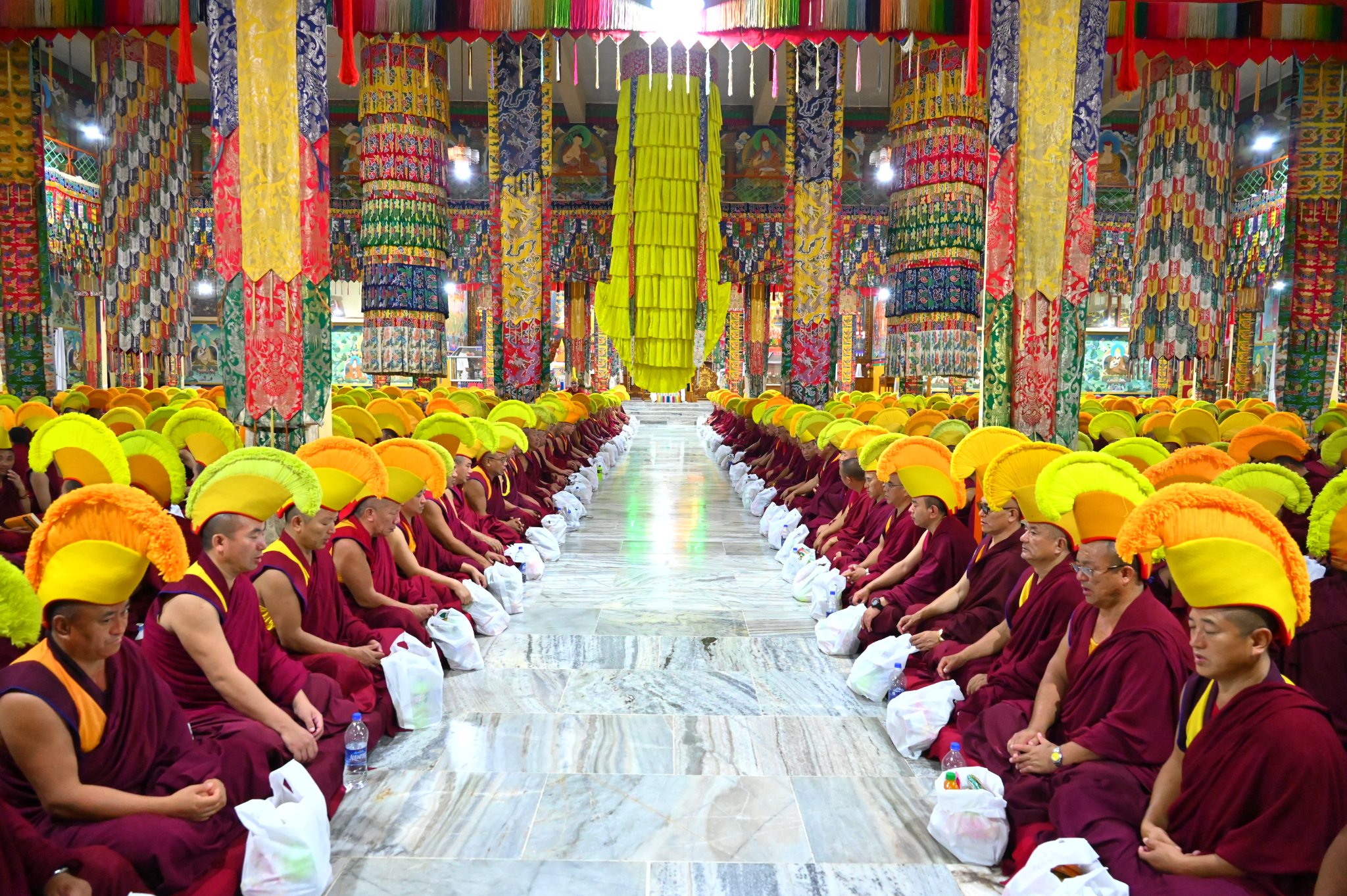
Sera Lachi puja on Chokhor Duchen.
Throughout the year, every Tibetan eighth and twenty-ninth day, on full moons, sun and moon eclipses, and on the four Buddha Days, when merit is multiplied 100 million times, the Puja Fund makes offerings to all the Sangha who offer the prayers and practices and this small monetary offering is one way that the Sangha are able to supplement their food, medical needs, or provide for other basic care items for themselves.
In addition, on the four Buddha Days offerings are made to His Holiness the Dalai Lama and all of Lama Zopa Rinpoche’s gurus, as well as all the IMI Sangha communities around the word.
Lama Zopa Rinpoche has explained, “when you are making offerings, whether to lay people or Sangha, if they have received teachings from His Holiness the Dalai Lama, and if they have the same guru as you – such as His Holiness the Dalai Lama – think that every one of the students is the pores of your guru. If you think that as you make offerings, then you collect unbelievable merit.
“You collect more merit than having made offerings to numberless buddhas, Dharma, and Sangha, and numberless statues, stupas, and scriptures in the ten directions. By thinking that this person is the guru’s pore and then offering one biscuit or one piece of candy, you collect much more merit than having made offerings to numberless buddhas, Dharma, Sangha, and numberless statues, stupas, and scriptures in the ten directions.”

Lama Zopa Rinpoche and monks and nuns receiving Vajrayogini oral transmissions from Geshe Lharampa Lobsang Drugdrag at Khachoe Ghakyil Nunnery, Nepal, March 2023. Photo by Ven. Lobsang Sherab.
Generating Extensive Merit for the Benefit for All
The extensive range of practices and pujas that are offered around the world through the Puja Fund is astounding. Offering these pujas and practices to holy objects and Sangha, on behalf of all FPMT centers, projects, and services, is one way of creating an incredible amount of merit and in this way helps the FPMT organization achieve its goals which stretch far into the future for the benefit of all.
So far, these offerings and pujas have not been publicized much, but I would like to make it known so that other people can participate in making these extensive offerings. The offering to all these monasteries happen continuously, every year, every month. My idea is for these offerings and pujas to continue forever or for as long as the monasteries exist. Please if you make offerings, please think in this way and dedicate and you can also remember on the actual day that the pujas are happening, rejoice and dedicate. This is the best business, the best way to create most extensive merit.
—Lama Zopa Rinpoche
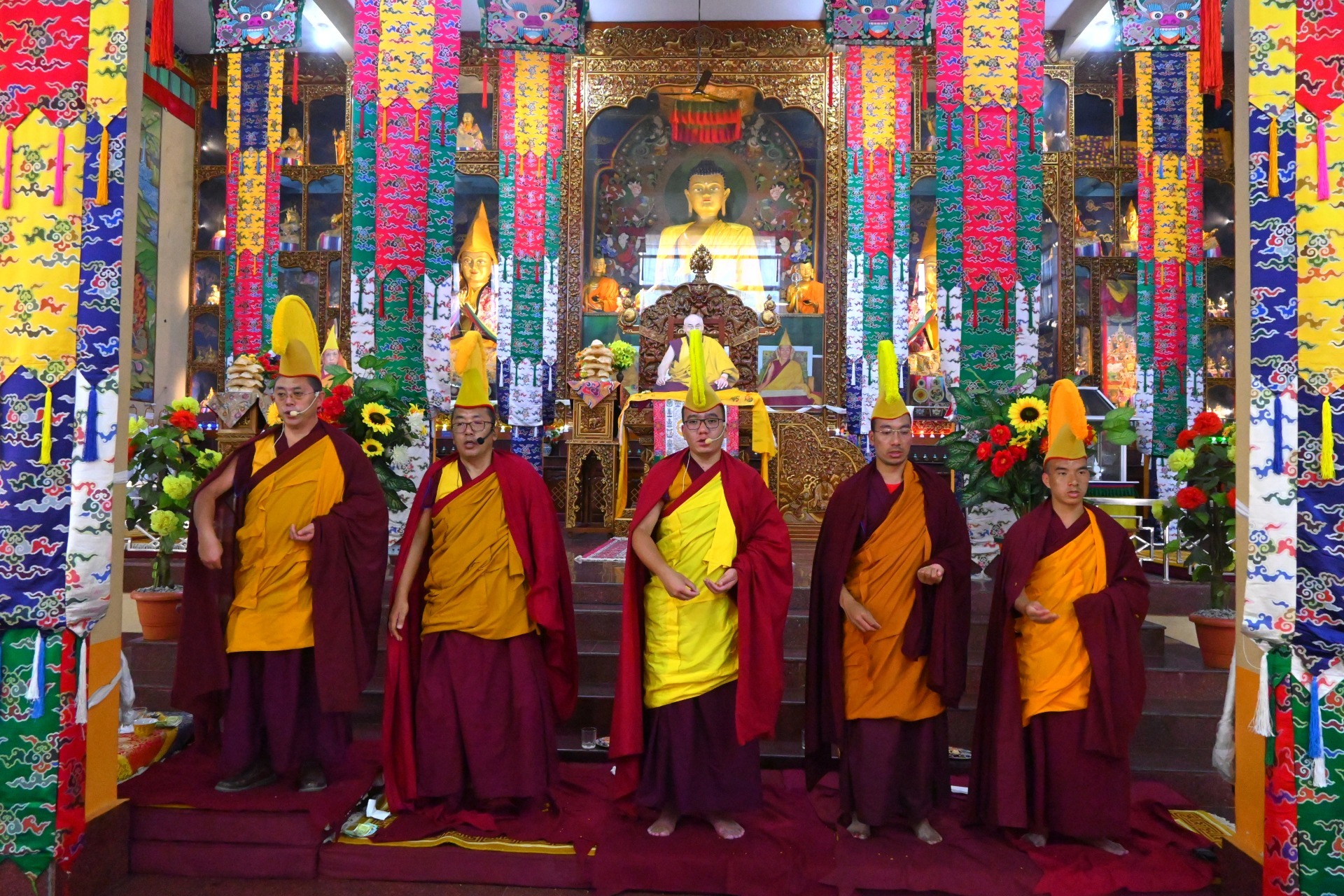
Sera Lachi Losar Monlam Puja 2023.
Pujas, Prayers, and Offerings on Special Days
Below we share details of the vast offerings and practices offered on the merit-multiplying days of Losar, Saka Dawa, Chokhor Duchen, and Lhabab Duchen as well as on the anniversary of the parinirvava of Lama Tsongkhapa, sun and moon eclipses and each month on full moons and the eighth and twenty-ninth Tibetan date.
Every year during the auspicious Buddha Days of Losar, Saka Dawa, Chokhor Duchen, and Lhabab Duchen, when the merit is magnified one hundred million times, the Puja Fund sponsors these pujas (that are offered by up to 10,000 ordained Sangha) and as well as various offerings that happen all over the world:
Offerings on all Buddha Days
These practices below are offered on all Buddha Days each year.
- Recitation of the Prajnaparamita Sutra by Gyudmed Tantric College.
- One Thousand Sets of Offerings to Buddha Namgyalma and 64 offerings to Kalarupa by Sera Je and Sera Mey Monasteries and Gyuto Tantric College.
- Medicine Buddha Puja and 64 offerings to Kalarupa by Gaden Jangtse and Shartse Monasteries.
- Namgyalma long life ritual and 64 offerings to Kalarupa by Drepung Gomang and Loseling Monasteries.
- Printing Sutras: Golden Light Sutra, Arya Sanghata Sutra, Vajra Cutter Sutra, Sutra of Great Liberation and Amitayus Long Life Sutra.
- 1,500 Animals liberated by the Animal Liberation Fund.
- Making tsa tsas of Mitukpa, the three long life deities and Kadampa stupas sponsored by the Stupa Fund.
Holy Objects in Nepal, India, and Tibet
- Painting the entire Bouddhanath and Swayambunath stupas and offering new umbrellas to the stupas’ pinnacles.
- Offering a new set of robes to the holy body of the main Buddha statue in the Mahabodhi Temple, Bodhgaya, India.
- When possible offering gold and new robes to the holy body of the Jowo Buddha statue in Lhasa, Tibet.
Gurus and Sangha
- Offerings are made to His Holiness the Dalai Lama and all of Lama Zopa Rinpoche’s gurus and to over 10,000 ordained Sangha around the world.
- Robes are offered to all FPMT geshes and resident teachers.
One Million Mani Retreats
Each year One Hundred Million Mani Retreat is sponsored at Tashi Chime Gatsal Nunnery, sometimes two retreats are sponsored. During this time all the food at the nunnery is sponsored, offerings are made to nuns and recently medical and educational support has also been covered.
Recitation of the Kangyur
Each year on Chokhor Duchen the nuns of Khachoe Ghakyil Ling Nunnery in Nepal recite the Kangyur.
Tara Puja for Saka Dawa
Recitation of the 100,000 Praises to Twenty-one Taras is offered by Sera Je and Sera Mey Monasteries and Khachoe Ghakyil Ling Nunnery.
To contribute toward these offerings, practices and the ongoing activities of the Puja Fund:
Every year on Lama Tsongkhapa Day, or Ganden Ngamchoe in Tibetan, is a celebration of the anniversary of Lama Tsongkhapa’s parinirvana. It is celebrated on the twenty-fifth day of the tenth month on the Tibetan calendar. On that day, the Puja Fund sponsors these special offerings to ordained Sangha around the world:
Special Meal and Dessert Offered to all the Sangha at IMI Communities
- Nalanda Monastery and Dorje Phagmo Nunnery, France
- Thubten Shedrup Ling and Chenrezig Sangha community, Australia
- Istituto Lama Tzong Khapa Sangha communities, Italy
- IMI House in Sera Je Monastery, India
Every year during each full sun and moon eclipse, when the merit is magnified 700,000 during lunar eclipse and 100 million during solar eclipses, the Puja Fund sponsors:
- Printing Sutras: Golden Light Sutra, Arya Sangata Sutra, Vajra Cutter Sutra, Sutra of Great Liberation and Amitayus Long Life Sutra.
- 1,500 Animals liberated by the Animal Liberation Fund.
- Making tsa tsas of Mitukpa, the three long life deities and Kadampa stupas sponsored by the Stupa Fund.
Every month on the full moon, and the eight and twenty ninth day, according to the Tibetan calendar, the Puja Fund sponsors these pujas:
Full Moons
- Painting the entire Bouddhanath and Swayambunath stupas and offering new umbrellas to the stupas’ pinnacles.
- Offering a new set of robes to the holy body of the main Buddha statue in the Mahabodhi Temple, Bodhgaya, India.
- Offering gold and new robes to the holy body of the Jowo Buddha statue in Lhasa, Tibet.
- Offering gold to a special Chenrezig statue inside the Potala palace in Tibet (when possible).
- 1,500 Animals liberated by the Animal Liberation Fund.
- Making tsa tsas of Padmasambhava, Mitukpa, the three long life deities and Kadampa stupas sponsored by the Stupa Fund.
Eighth Day of the Tibetan Month
Every month on the eighth day of the Tibetan month, which is an important day to offer long life practices.
- Extensive Medicine Buddha Puja by Sera Mey Monastery. This practice is a specialty of Sera Mey Monastery – the monks are experts in this practice and offer it with strong prayers.
- 1,500 Animals Liberated by the Animal Liberation Fund.
- Making tsa tsas of the eight Medicine Buddhas, Mitukpa, the three long life deities and Kadampa stupas sponsored by the Stupa Fund.
Twenty-ninth Day of the Tibetan Month
Every month on the twenty-ninth day of the Tibetan month, which is a powerful day for doing practices such as Most Secret Hayagriva, the Puja Fund sponsors the Most Secret Hayagriva Tsog Kong by forty of the most senior monks of Sera Je Monastery, who specialize in the practice of Most Secret Hayagriva. This is an all-day puja with an elaborate torma offering and the puja has extensive prayers and meditation.
Monthly
These pujas and practices are sponsored monthly to pacify the elements and protect those harmed by disasters of earth, wind, fire, and water.
- Extensive Medicine Buddha Puja offered five times by Drepung Gomang Monastery, Kopan Monastery, and Gyuto Tantric College.
- Guhyasamaja root text recited four times by Kopan lama gyupas.
- Kshitigarbha Sutra recited one time by the nuns of Khachoe Ghakyil Ling.
- Golden Light Sutra recited eight times by Sangha.
- Arya Sanghata Sutra recited five times by Sangha.
- Vajra Cutter Sutra recited four times by Sangha.
Budget
The annual expense for offering these pujas, practices and prayers, as well as offerings to the holy objects is over US$150,000. You are welcome to join in these incredible vast merit-making practices by offering any amount. In this way you are a part of every practice and prayer made.
Join in this vast array of offerings and practices by contributing any amount:
When offering any puja, think: I am doing this for any sentient being who needs it. Motivate for everyone, not working for yourself, not for money, offering puja becomes pure Dharma motivation because of the thought to benefit others. Then, when people are dying and sick and in need, if you think of those people, so many need helpful prayers. “Whatever you do, try to benefit sentient beings, not just recite prayer.
—Lama Zopa Rinpoche
Puja Fund News & Updates
Rejoicing in All the Pujas and Prayers Offered During Saka Dawa
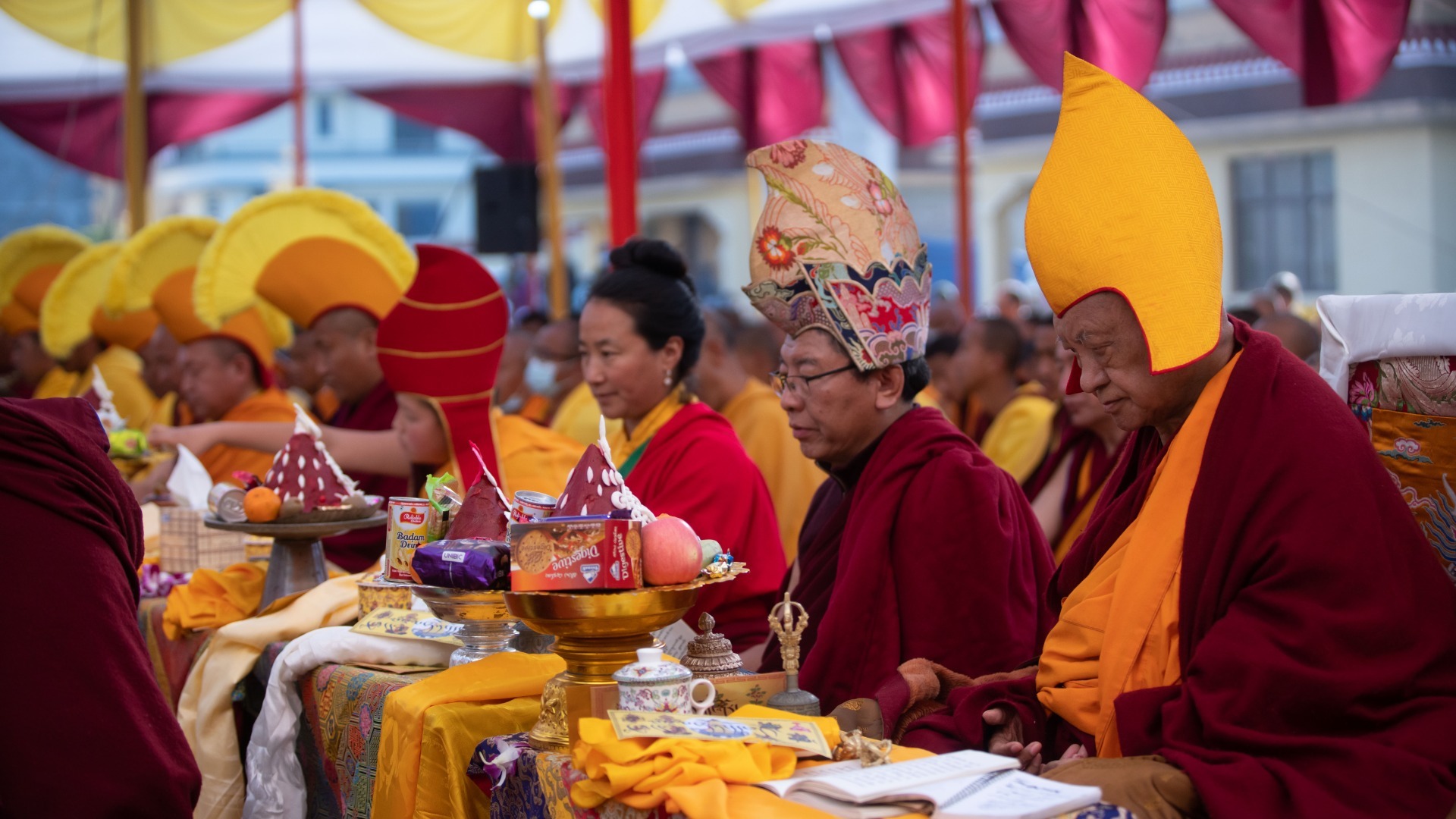
Lama Zopa Rinpoche, Tsoknyi Rinpoche, and Khadro-la during 100,000 tsog offerings to Guru Rinpoche in front of the giant Guru Rinpoche thangka at Kopan Nunnery, Nepal, January 2023. Photo by Ven. Lobsang Sherab.
The Puja Fund is a project of FPMT Inc. and is administered by FPMT International Office located in Portland, Oregon, United States. All donations made to this fund are tax-deductible within the United States in accordance with IRS Code article 501(c)(3) to the extent allowed by law.
For larger donations, wire transfers, or check donations, contact FPMT Donor Services.
For questions about the Social Services Fund activities, please contact the Charitable Projects Coordinator.
Return to FPMT Charitable Projects Homepage
- Tagged: fpmt projects, puja, puja fund
